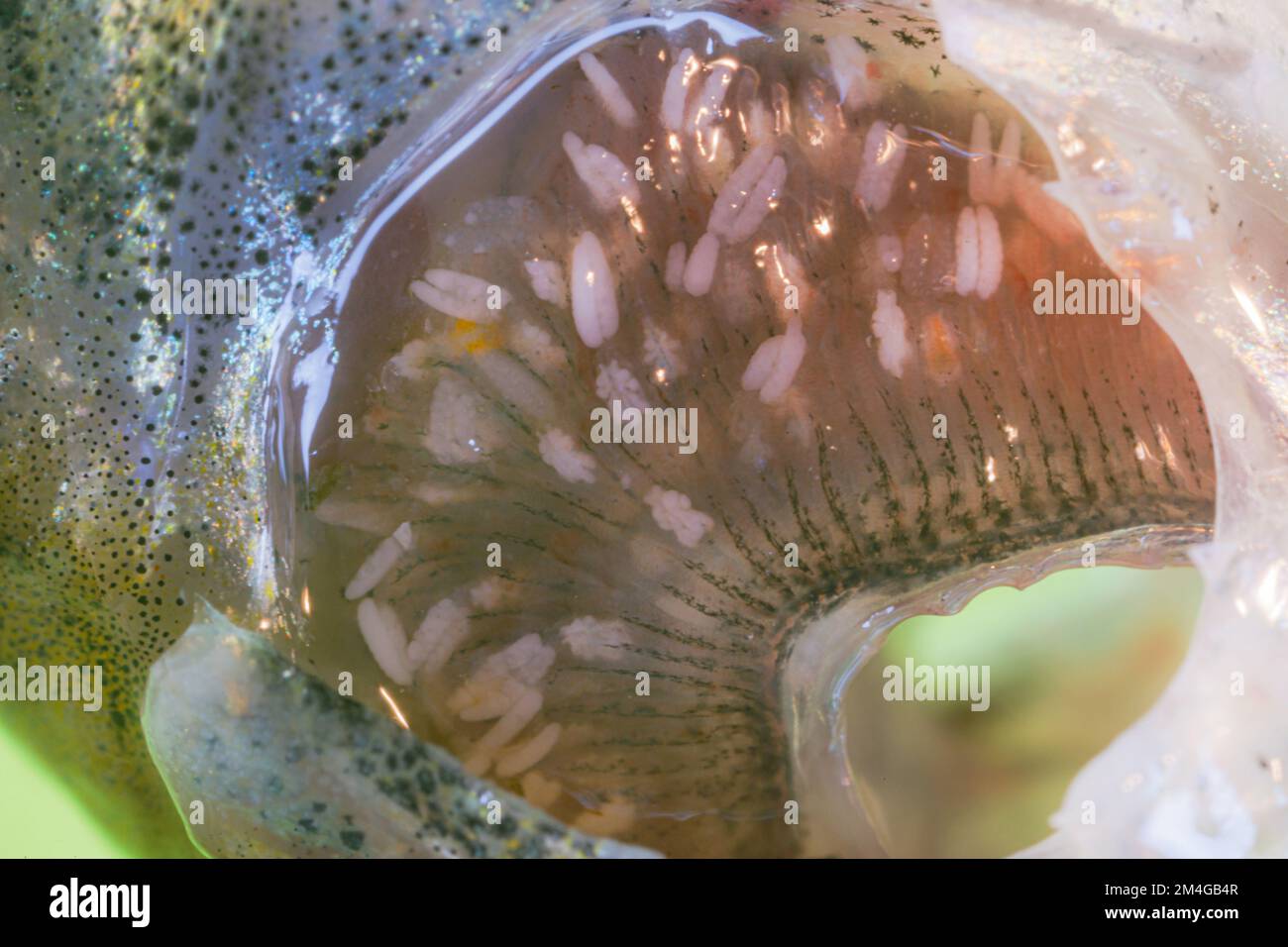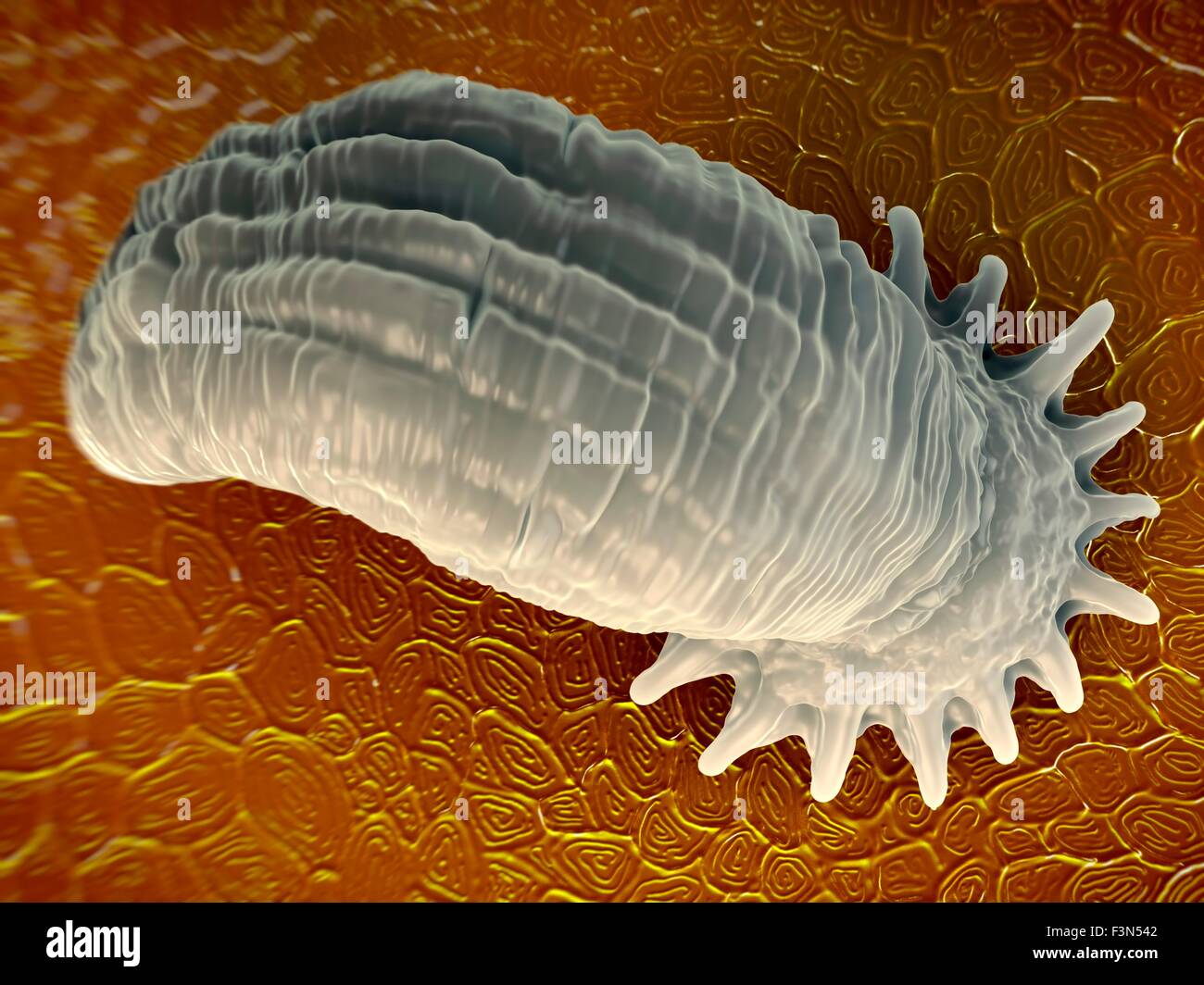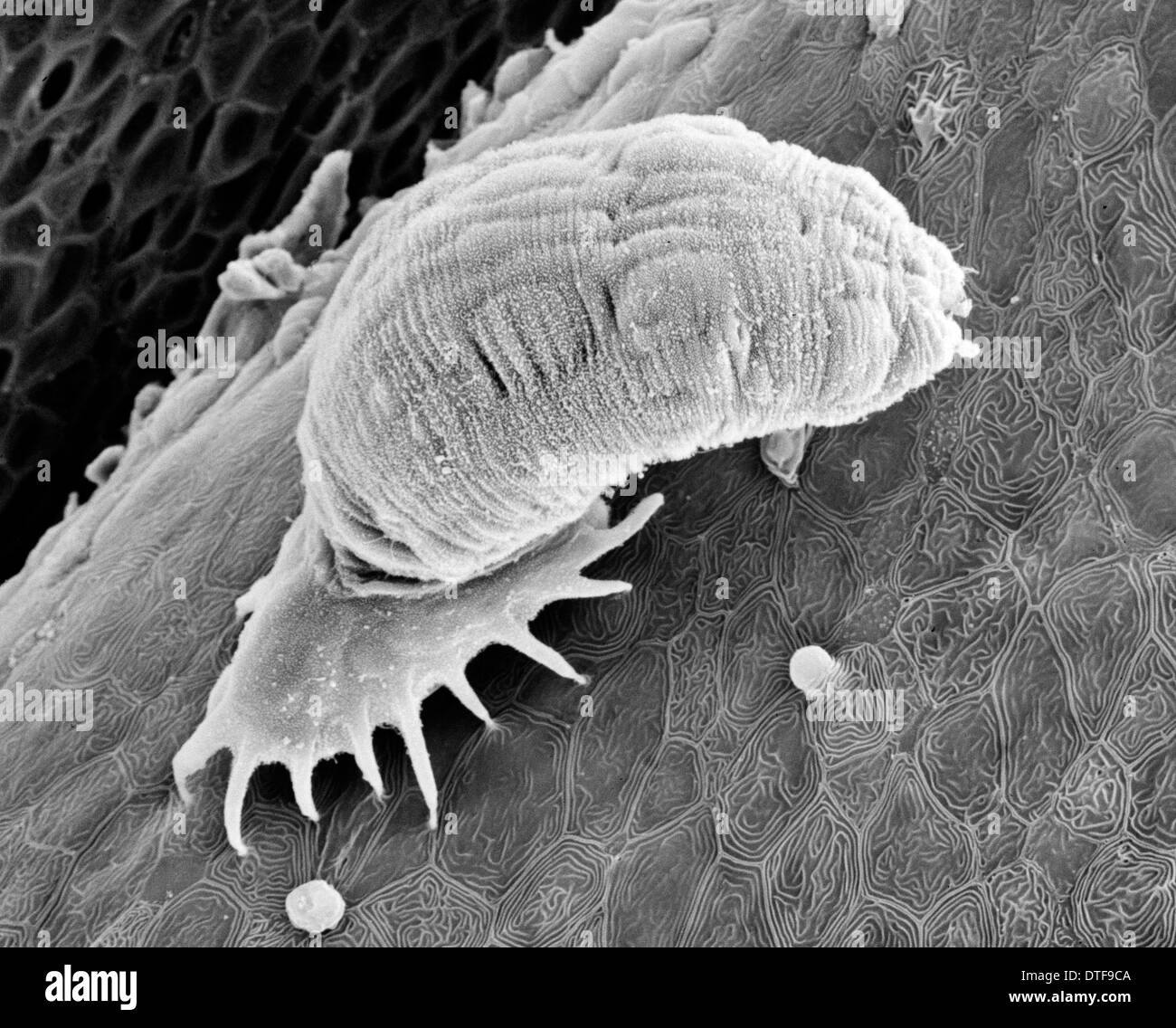Quick filters:
Monogenea Stock Photos and Images
 flatworm (Monogenea), severe infestation on the gill of a minnow, Germany Stock Photohttps://www.alamy.com/image-license-details/?v=1https://www.alamy.com/flatworm-monogenea-severe-infestation-on-the-gill-of-a-minnow-germany-image501919287.html
flatworm (Monogenea), severe infestation on the gill of a minnow, Germany Stock Photohttps://www.alamy.com/image-license-details/?v=1https://www.alamy.com/flatworm-monogenea-severe-infestation-on-the-gill-of-a-minnow-germany-image501919287.htmlRM2M4GB4R–flatworm (Monogenea), severe infestation on the gill of a minnow, Germany
 Doppeltier, Diplozoon paradoxum gehört zur Klasse der Monogenea innerhalb der Cercomeromorpha, Bamdwurm, Historisch, digital restaurierte Reproduktion von einer Vorlage aus dem 19. Jahrhundert Stock Photohttps://www.alamy.com/image-license-details/?v=1https://www.alamy.com/doppeltier-diplozoon-paradoxum-gehrt-zur-klasse-der-monogenea-innerhalb-der-cercomeromorpha-bamdwurm-historisch-digital-restaurierte-reproduktion-von-einer-vorlage-aus-dem-19-jahrhundert-image513296660.html
Doppeltier, Diplozoon paradoxum gehört zur Klasse der Monogenea innerhalb der Cercomeromorpha, Bamdwurm, Historisch, digital restaurierte Reproduktion von einer Vorlage aus dem 19. Jahrhundert Stock Photohttps://www.alamy.com/image-license-details/?v=1https://www.alamy.com/doppeltier-diplozoon-paradoxum-gehrt-zur-klasse-der-monogenea-innerhalb-der-cercomeromorpha-bamdwurm-historisch-digital-restaurierte-reproduktion-von-einer-vorlage-aus-dem-19-jahrhundert-image513296660.htmlRF2MR2K3G–Doppeltier, Diplozoon paradoxum gehört zur Klasse der Monogenea innerhalb der Cercomeromorpha, Bamdwurm, Historisch, digital restaurierte Reproduktion von einer Vorlage aus dem 19. Jahrhundert
 Diplozoon paradoxum, Print, Diplozoon paradoxum is a flatworm (platyhelminth) from the class Monogenea found in freshwater fishes in Asia and Europe and known for its complete monogamy. This parasite is commonly found on the gills of European cyprinid fishes. It is usually around 0.7 centimeters long (approximately the size of a fingernail) and has bilateral symmetry. It has several hooks at its mouth which it uses to grab on to the gills of a fish. From there it feeds on the blood of a cyprinid Stock Photohttps://www.alamy.com/image-license-details/?v=1https://www.alamy.com/diplozoon-paradoxum-print-diplozoon-paradoxum-is-a-flatworm-platyhelminth-from-the-class-monogenea-found-in-freshwater-fishes-in-asia-and-europe-and-known-for-its-complete-monogamy-this-parasite-is-commonly-found-on-the-gills-of-european-cyprinid-fishes-it-is-usually-around-07-centimeters-long-approximately-the-size-of-a-fingernail-and-has-bilateral-symmetry-it-has-several-hooks-at-its-mouth-which-it-uses-to-grab-on-to-the-gills-of-a-fish-from-there-it-feeds-on-the-blood-of-a-cyprinid-image328678050.html
Diplozoon paradoxum, Print, Diplozoon paradoxum is a flatworm (platyhelminth) from the class Monogenea found in freshwater fishes in Asia and Europe and known for its complete monogamy. This parasite is commonly found on the gills of European cyprinid fishes. It is usually around 0.7 centimeters long (approximately the size of a fingernail) and has bilateral symmetry. It has several hooks at its mouth which it uses to grab on to the gills of a fish. From there it feeds on the blood of a cyprinid Stock Photohttps://www.alamy.com/image-license-details/?v=1https://www.alamy.com/diplozoon-paradoxum-print-diplozoon-paradoxum-is-a-flatworm-platyhelminth-from-the-class-monogenea-found-in-freshwater-fishes-in-asia-and-europe-and-known-for-its-complete-monogamy-this-parasite-is-commonly-found-on-the-gills-of-european-cyprinid-fishes-it-is-usually-around-07-centimeters-long-approximately-the-size-of-a-fingernail-and-has-bilateral-symmetry-it-has-several-hooks-at-its-mouth-which-it-uses-to-grab-on-to-the-gills-of-a-fish-from-there-it-feeds-on-the-blood-of-a-cyprinid-image328678050.htmlRM2A2MG5P–Diplozoon paradoxum, Print, Diplozoon paradoxum is a flatworm (platyhelminth) from the class Monogenea found in freshwater fishes in Asia and Europe and known for its complete monogamy. This parasite is commonly found on the gills of European cyprinid fishes. It is usually around 0.7 centimeters long (approximately the size of a fingernail) and has bilateral symmetry. It has several hooks at its mouth which it uses to grab on to the gills of a fish. From there it feeds on the blood of a cyprinid
 Gyrodactylus aquatic parasite Stock Photohttps://www.alamy.com/image-license-details/?v=1https://www.alamy.com/stock-photo-gyrodactylus-aquatic-parasite-88360834.html
Gyrodactylus aquatic parasite Stock Photohttps://www.alamy.com/image-license-details/?v=1https://www.alamy.com/stock-photo-gyrodactylus-aquatic-parasite-88360834.htmlRFF3N542–Gyrodactylus aquatic parasite
 Gyrodactylus, aquatic parasite Stock Photohttps://www.alamy.com/image-license-details/?v=1https://www.alamy.com/gyrodactylus-aquatic-parasite-image66719530.html
Gyrodactylus, aquatic parasite Stock Photohttps://www.alamy.com/image-license-details/?v=1https://www.alamy.com/gyrodactylus-aquatic-parasite-image66719530.htmlRMDTF9CA–Gyrodactylus, aquatic parasite
![. Elementary text-book of zoology [electronic resource]. Zoology. PL A T YHELMINTHES. The life-history may be illustrated diagrammatically : — PHYLUM PLATYHELMINTHES. The Platyhelminthes, or flat-worms, form a well- defined group of the affinities of which little is known. The two types given, Distomum and TcE?iia, represent the two " parasitic" classes of the phylum. 1. Trematoda.—The Trematoda are all parasites, the Monogenea are mostly ectoparasites with one host, and the Digenea are endoparasites with two hosts. 2. Cestoda.—The Cestoda illustrate enteric parasitism with entire lo Stock Photo . Elementary text-book of zoology [electronic resource]. Zoology. PL A T YHELMINTHES. The life-history may be illustrated diagrammatically : — PHYLUM PLATYHELMINTHES. The Platyhelminthes, or flat-worms, form a well- defined group of the affinities of which little is known. The two types given, Distomum and TcE?iia, represent the two " parasitic" classes of the phylum. 1. Trematoda.—The Trematoda are all parasites, the Monogenea are mostly ectoparasites with one host, and the Digenea are endoparasites with two hosts. 2. Cestoda.—The Cestoda illustrate enteric parasitism with entire lo Stock Photo](https://c8.alamy.com/comp/RJND3J/elementary-text-book-of-zoology-electronic-resource-zoology-pl-a-t-yhelminthes-the-life-history-may-be-illustrated-diagrammatically-phylum-platyhelminthes-the-platyhelminthes-or-flat-worms-form-a-well-defined-group-of-the-affinities-of-which-little-is-known-the-two-types-given-distomum-and-tceiia-represent-the-two-quot-parasiticquot-classes-of-the-phylum-1-trematodathe-trematoda-are-all-parasites-the-monogenea-are-mostly-ectoparasites-with-one-host-and-the-digenea-are-endoparasites-with-two-hosts-2-cestodathe-cestoda-illustrate-enteric-parasitism-with-entire-lo-RJND3J.jpg) . Elementary text-book of zoology [electronic resource]. Zoology. PL A T YHELMINTHES. The life-history may be illustrated diagrammatically : — PHYLUM PLATYHELMINTHES. The Platyhelminthes, or flat-worms, form a well- defined group of the affinities of which little is known. The two types given, Distomum and TcE?iia, represent the two " parasitic" classes of the phylum. 1. Trematoda.—The Trematoda are all parasites, the Monogenea are mostly ectoparasites with one host, and the Digenea are endoparasites with two hosts. 2. Cestoda.—The Cestoda illustrate enteric parasitism with entire lo Stock Photohttps://www.alamy.com/image-license-details/?v=1https://www.alamy.com/elementary-text-book-of-zoology-electronic-resource-zoology-pl-a-t-yhelminthes-the-life-history-may-be-illustrated-diagrammatically-phylum-platyhelminthes-the-platyhelminthes-or-flat-worms-form-a-well-defined-group-of-the-affinities-of-which-little-is-known-the-two-types-given-distomum-and-tceiia-represent-the-two-quot-parasiticquot-classes-of-the-phylum-1-trematodathe-trematoda-are-all-parasites-the-monogenea-are-mostly-ectoparasites-with-one-host-and-the-digenea-are-endoparasites-with-two-hosts-2-cestodathe-cestoda-illustrate-enteric-parasitism-with-entire-lo-image235269878.html
. Elementary text-book of zoology [electronic resource]. Zoology. PL A T YHELMINTHES. The life-history may be illustrated diagrammatically : — PHYLUM PLATYHELMINTHES. The Platyhelminthes, or flat-worms, form a well- defined group of the affinities of which little is known. The two types given, Distomum and TcE?iia, represent the two " parasitic" classes of the phylum. 1. Trematoda.—The Trematoda are all parasites, the Monogenea are mostly ectoparasites with one host, and the Digenea are endoparasites with two hosts. 2. Cestoda.—The Cestoda illustrate enteric parasitism with entire lo Stock Photohttps://www.alamy.com/image-license-details/?v=1https://www.alamy.com/elementary-text-book-of-zoology-electronic-resource-zoology-pl-a-t-yhelminthes-the-life-history-may-be-illustrated-diagrammatically-phylum-platyhelminthes-the-platyhelminthes-or-flat-worms-form-a-well-defined-group-of-the-affinities-of-which-little-is-known-the-two-types-given-distomum-and-tceiia-represent-the-two-quot-parasiticquot-classes-of-the-phylum-1-trematodathe-trematoda-are-all-parasites-the-monogenea-are-mostly-ectoparasites-with-one-host-and-the-digenea-are-endoparasites-with-two-hosts-2-cestodathe-cestoda-illustrate-enteric-parasitism-with-entire-lo-image235269878.htmlRMRJND3J–. Elementary text-book of zoology [electronic resource]. Zoology. PL A T YHELMINTHES. The life-history may be illustrated diagrammatically : — PHYLUM PLATYHELMINTHES. The Platyhelminthes, or flat-worms, form a well- defined group of the affinities of which little is known. The two types given, Distomum and TcE?iia, represent the two " parasitic" classes of the phylum. 1. Trematoda.—The Trematoda are all parasites, the Monogenea are mostly ectoparasites with one host, and the Digenea are endoparasites with two hosts. 2. Cestoda.—The Cestoda illustrate enteric parasitism with entire lo
 Gyrodactylus aquatic parasites Stock Photohttps://www.alamy.com/image-license-details/?v=1https://www.alamy.com/stock-photo-gyrodactylus-aquatic-parasites-88360835.html
Gyrodactylus aquatic parasites Stock Photohttps://www.alamy.com/image-license-details/?v=1https://www.alamy.com/stock-photo-gyrodactylus-aquatic-parasites-88360835.htmlRFF3N543–Gyrodactylus aquatic parasites
 . Bulletin. Science; Natural history; Natural history. I>)73 RESEARCH No 11 S /// appeared mature, none had eggs. Yamaguti (Sys- tenia Helminthum, Vol. IV. Monogenea and AspidO' cotylea. [ntersci. Publ., New York, 1963) stated thai members of the genus Dlclidophora are pa'fa- sitic on the fish families Gadidae, Merlucciidae, and Macrouridae. The presenl paper adds the family Myctophidae. Monogenetie trematodes are gener- ally considered lo be hosi specific. W. E. Martin, Dept. Biological Sciences, Univ. Southern California, Los Angeles, California 'W<)<)7. Accepted tor publication M;i Stock Photohttps://www.alamy.com/image-license-details/?v=1https://www.alamy.com/bulletin-science-natural-history-natural-history-igt73-research-no-11-s-appeared-mature-none-had-eggs-yamaguti-sys-tenia-helminthum-vol-iv-monogenea-and-aspido-cotylea-ntersci-publ-new-york-1963-stated-thai-members-of-the-genus-dlclidophora-are-pafa-sitic-on-the-fish-families-gadidae-merlucciidae-and-macrouridae-the-presenl-paper-adds-the-family-myctophidae-monogenetie-trematodes-are-gener-ally-considered-lo-be-hosi-specific-w-e-martin-dept-biological-sciences-univ-southern-california-los-angeles-california-wltlt7-accepted-tor-publication-mi-image234186537.html
. Bulletin. Science; Natural history; Natural history. I>)73 RESEARCH No 11 S /// appeared mature, none had eggs. Yamaguti (Sys- tenia Helminthum, Vol. IV. Monogenea and AspidO' cotylea. [ntersci. Publ., New York, 1963) stated thai members of the genus Dlclidophora are pa'fa- sitic on the fish families Gadidae, Merlucciidae, and Macrouridae. The presenl paper adds the family Myctophidae. Monogenetie trematodes are gener- ally considered lo be hosi specific. W. E. Martin, Dept. Biological Sciences, Univ. Southern California, Los Angeles, California 'W<)<)7. Accepted tor publication M;i Stock Photohttps://www.alamy.com/image-license-details/?v=1https://www.alamy.com/bulletin-science-natural-history-natural-history-igt73-research-no-11-s-appeared-mature-none-had-eggs-yamaguti-sys-tenia-helminthum-vol-iv-monogenea-and-aspido-cotylea-ntersci-publ-new-york-1963-stated-thai-members-of-the-genus-dlclidophora-are-pafa-sitic-on-the-fish-families-gadidae-merlucciidae-and-macrouridae-the-presenl-paper-adds-the-family-myctophidae-monogenetie-trematodes-are-gener-ally-considered-lo-be-hosi-specific-w-e-martin-dept-biological-sciences-univ-southern-california-los-angeles-california-wltlt7-accepted-tor-publication-mi-image234186537.htmlRMRH038W–. Bulletin. Science; Natural history; Natural history. I>)73 RESEARCH No 11 S /// appeared mature, none had eggs. Yamaguti (Sys- tenia Helminthum, Vol. IV. Monogenea and AspidO' cotylea. [ntersci. Publ., New York, 1963) stated thai members of the genus Dlclidophora are pa'fa- sitic on the fish families Gadidae, Merlucciidae, and Macrouridae. The presenl paper adds the family Myctophidae. Monogenetie trematodes are gener- ally considered lo be hosi specific. W. E. Martin, Dept. Biological Sciences, Univ. Southern California, Los Angeles, California 'W<)<)7. Accepted tor publication M;i
 . Brehms Tierleben. Allgemeine kunde des Tierreichs. Zoology; Animal behavior. ©augiuütniei: Monogenea. 211 unberftanbeneg S^ätfel, bi§ ö. Sr^olb bie übercafd;enbe Söfung fanb. ©3 ^anbelt ficf) um einen (Sauglüurm, ber in ber ^ugenb bie Giemen üon ©üfeftiajfecfifdien auffudjt unb fdjon längft befannt, jebod) für eine befonbere ©attung, Diporpa, geljalten nporben tvax. S)iefe S)i|jor|)en (c) [teilen nöntlid) iebe ein tüirilid) einzelnes ^nbibibuum bar, ha^ alle SJlerfmale ber gamilie befi|t, nur ba^ bie ^ortljflangungSorgane noc^ nid)t ou^gebilbet finb. '^adj einiger ^et finbet bann bie SSerei Stock Photohttps://www.alamy.com/image-license-details/?v=1https://www.alamy.com/brehms-tierleben-allgemeine-kunde-des-tierreichs-zoology-animal-behavior-augiutniei-monogenea-211-unberftanbeneg-stfel-bi-srolb-bie-bercafdenbe-sfung-fanb-3-anbelt-ficf-um-einen-sauglurm-ber-in-ber-ugenb-bie-giemen-on-feftiajfecfifdien-auffudjt-unb-fdjon-lngft-befannt-jebod-fr-eine-befonbere-attung-diporpa-geljalten-nporben-tvax-siefe-sijoren-c-teilen-nntlid-iebe-ein-tirilid-einzelnes-nbibibuum-bar-ha-alle-sjlerfmale-ber-gamilie-befit-nur-ba-bie-ortljflangungsorgane-noc-nidt-ougebilbet-finb-adj-einiger-et-finbet-bann-bie-sserei-image234297828.html
. Brehms Tierleben. Allgemeine kunde des Tierreichs. Zoology; Animal behavior. ©augiuütniei: Monogenea. 211 unberftanbeneg S^ätfel, bi§ ö. Sr^olb bie übercafd;enbe Söfung fanb. ©3 ^anbelt ficf) um einen (Sauglüurm, ber in ber ^ugenb bie Giemen üon ©üfeftiajfecfifdien auffudjt unb fdjon längft befannt, jebod) für eine befonbere ©attung, Diporpa, geljalten nporben tvax. S)iefe S)i|jor|)en (c) [teilen nöntlid) iebe ein tüirilid) einzelnes ^nbibibuum bar, ha^ alle SJlerfmale ber gamilie befi|t, nur ba^ bie ^ortljflangungSorgane noc^ nid)t ou^gebilbet finb. '^adj einiger ^et finbet bann bie SSerei Stock Photohttps://www.alamy.com/image-license-details/?v=1https://www.alamy.com/brehms-tierleben-allgemeine-kunde-des-tierreichs-zoology-animal-behavior-augiutniei-monogenea-211-unberftanbeneg-stfel-bi-srolb-bie-bercafdenbe-sfung-fanb-3-anbelt-ficf-um-einen-sauglurm-ber-in-ber-ugenb-bie-giemen-on-feftiajfecfifdien-auffudjt-unb-fdjon-lngft-befannt-jebod-fr-eine-befonbere-attung-diporpa-geljalten-nporben-tvax-siefe-sijoren-c-teilen-nntlid-iebe-ein-tirilid-einzelnes-nbibibuum-bar-ha-alle-sjlerfmale-ber-gamilie-befit-nur-ba-bie-ortljflangungsorgane-noc-nidt-ougebilbet-finb-adj-einiger-et-finbet-bann-bie-sserei-image234297828.htmlRMRH557G–. Brehms Tierleben. Allgemeine kunde des Tierreichs. Zoology; Animal behavior. ©augiuütniei: Monogenea. 211 unberftanbeneg S^ätfel, bi§ ö. Sr^olb bie übercafd;enbe Söfung fanb. ©3 ^anbelt ficf) um einen (Sauglüurm, ber in ber ^ugenb bie Giemen üon ©üfeftiajfecfifdien auffudjt unb fdjon längft befannt, jebod) für eine befonbere ©attung, Diporpa, geljalten nporben tvax. S)iefe S)i|jor|)en (c) [teilen nöntlid) iebe ein tüirilid) einzelnes ^nbibibuum bar, ha^ alle SJlerfmale ber gamilie befi|t, nur ba^ bie ^ortljflangungSorgane noc^ nid)t ou^gebilbet finb. '^adj einiger ^et finbet bann bie SSerei